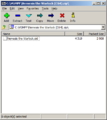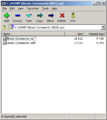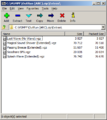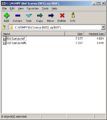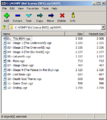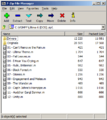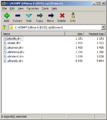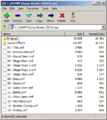Editing Rules: Rips
A Game Rip is a collection of files from a game stored in a zip archive that include all of the necessary audio files to reconstruct the game's soundtrack. This guide will explain the expected VGMPF format for creating and uploading game rips so that they meet a common standard.
Contents
Naming
- The name of the zip archive should match the name used in the file name of the Vorbis recording. That is, it should be unique enough to identify the game, but not so exhaustive as to be cumbersome. For example, "Ultima VI: The False Prophet (DOS)" can be shortened to "Ultima 6 (DOS)".
- Note that the platform should match those in the platform list and be surrounded by parenthesis.
Archive Layouts
This section will point to existing rips and show you what sort of structure you should use with in your rip files.
Single File Archives
Rips with only a single file are the easiest and are common among formats which combine all the tracks in a single file like NSF, SID, and AY. Notice that the zip archive below contains one file named after the game and name the zip file name is the same as the game's page.
It's possible that multiple rips will be made from combined track formats. This is especially common in NES games that have both NSF and NSFE formats made. Each should be put in the zip archive.
Several game music players support M3U playlists to add timing and title information to the file, like KSS, GBS, and others.
Nemesis the Warlock (C64) - 1 file.
Bionic Commando (NES) - 2 files.
Dragon Slayer IV: Drasle Family (MSX) - 1 file with playlist.
Logged Music Archives
Several formats are made by logging the data sent to audio chips. These formats include VGM, SPC, and DRO. Each song is logged to an individual file. The song files in these rips should have the same track numbers and song titles as those in the game page. If necessary, additional music can be added to the rip like songs with different timing or modified tracks with excluded or included sound effects which you can see in the Extras folder in this rip from OutRun (ARC).
Mixed Rip Formats
Since the objective of the rip archives is to include ripped music in all possible formats, there will come times when the ripped music exists in mixed types like NSF and VGM. In these cases, individual folders should be made for each rip format to avoid confusion of having them all in a single folder. This example comes from Kid Icarus: Angel Land Story (NES).
Computer Rips
Rips for computer platforms like DOS, Amiga, and PC-88 are often very complex so their may be several different sub-folders. Ultima VI: The False Prophet (DOS) and Dyna Blaster (DOS) are helpful examples.
- The music files used to make the soundtrack recording should be placed in the root folder and numbered and named after the game's soundtrack with any instrument files necessary for playback with them.
- Files not needed for playback, like drivers or instrument files that have since been incorporated into the rips can be put into a Drivers folder.
- All of the original ripped files should be placed in a folder named Originals with their original file names and extensions intact.
- Ripped sound effects are optional since this is a music web site, but if you're able to extract them, they should be placed in a folder called Sound Effects'.
The root contains the playable M files with their correct names.
Template
Adding the rip to a game page is simple and uses the templates, Format and Rips. By viewing the source of this page, you can see exactly how it's done.
Single Format Rip
Games that only use a single format in their rips, like Nemesis the Warlock (C64), look like this:
Multiple Format Rip
Games with multiple formats, like Kid Icarus: Angel Land Story (NES), look like this:
Rips to Exclude
Some games use digital audio files for their music. These files will sound the same as the Vorbis recording, and since they take up so much disk space, if the rip exceeds 10 MB, they should be excluded. Examples of lossless audio codecs include: AAC, AIFF, AU, AUD, CD, IFF, FLAC, RAW, VOC, WAV, and WMA. Although, keep in mind that some of these formats support lossy codecs which must be handled differently.
Some games use digital audio files for music, but use a lossy audio codec. Lossy audio codecs should also be excluded from a game rip. However, since transcoding one lossy codec to another has detrimental effects, it is acceptable to use the lossy audio format as the recording rather than make an OGG recording. However, if you need to make alterations to the file (like by adding looping), you should transcode the format to OGG since you'll be re-saving the file anyway. Lossy codecs that should be left in their native format include AAC, ASF, MP3, OGG, WAV, and WMA. Keep in mind that some of these formats support lossless codecs, and if they are used, the rips should be treated like the lossless codecs above.
Naturally, any games that use OGG music should have its rip excluded since the rip will be identical to the recording, so simply upload the game music.
Incomplete Rips
While you should strive to get a complete rip of a game's soundtrack, this is sometimes not possible, and specific songs have to be left out. When this happens, use the Issue Rip template so later users can rip the missing songs.
